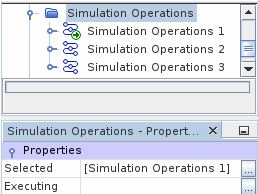Simulation Operations
Simulation operations allow you to automate the solution processes in Simcenter STAR-CCM+ without using Java macros. Condition and loop operations provide the basic logic control common to many programming languages.
Simulation operations interact with other control features in the Simcenter STAR-CCM+ interface. For example, the Solve Continua operation activates solvers that belong to models chosen for a particular physics continuum, and iterates until solver-specific convergence criteria are met.
The Simulation Operations: Multi-Timescale Conjugate Heat Transfer tutorial shows how you can apply simulation operations in the context of conjugate heat transfer. In addition, the following examples show how you can apply simulation operations in this and other scenarios:
You set up a simulation operation sequence under the node:

When you have created a simulation operation
sequence, additional actions appear in the Solution toolbar by which you can select and run a
simulation operation sequence. To run the simulation operation sequence, you select one
sequence as active and execute the run using the  icons on the tool bar. See also: Running a Simulation Operation Sequence.
icons on the tool bar. See also: Running a Simulation Operation Sequence.

You can also right-click the simulation operation sequence in the simulation tree and choose actions that execute the sequence:

Although you can use simulation operations for simple automation tasks, you can also build complex simulation scenarios in conjunction with template simulation files. In a template file, you avoid making static part selections, but instead rely on predicate matching within dynamic queries. By this approach you can build a repeatable simulation pipeline that runs on multiple CAD import files, provided the imported files use similar naming conventions. For an example of how to create a template simulation, see the tutorial, Usability: Creating a Template Simulation File.
For pre-processing, you can build automated pipelines using the node. Within simulation operations, you can execute this pipeline using the Mesh operation, as shown in Moving Box using Morpher and Remeshing.
- Clear Solution
- Launches the action of clearing the storage associated with the solution. See Clear Solution.
- Condition
- The condition operation evaluates a specified condition and branches to one of its two child sequences. See Condition.
- Initialize Solution
- Specify the position in the simulation sequence where the solution is initialized. See Initialize Solution.
- Loop
- A loop operation contains one
child sequence that it executes repeatedly until the loop evaluates to
false.
See Loop.
- Mesh
- The mesh operation launches the volume mesh generation action for a parts-based mesh pipeline. See Mesh.
- Remove Invalid Cells
- The Remove Invalid Cells operation removes poor quality cells based on specified mesh criteria. See Remove Invalid Cells.
- Stopping Simulation Operations
- Provides an automatic way for stopping the operation sequence during its run. See Stopping Simulation Operations.
- Run Flamelet Table Generator
- Requires that a flamelet model is selected in the physics continuum. Generates the relevant flamelet table. See Run Flamelet Table Generator.
- Run Reactor Network
- Requires that the Reactor Network model and a flamelet model are selected in the physics continuum. Clusters computational mesh cells into the specified number of reactors. See Run Reactor Network.
- Save Simulation
- Allows you to save the simulation, throughout the simulation operation sequence. See Save Simulation.
- Set Active Stage
- Activates the selected Stage in the sequence. See Set Active Stage.
- Set Scalar Parameter
- Allows you to set the value of scalar global parameters during an operation sequence. See Set Scalar Parameter.
- Solve Adjoint
- Combines the adjoint run with selected analytics run based on the adjoint result. See Solve Adjoint.
- Solve Physics
- Runs the solvers associated with the selected simulation objects, which can be either physics continua or time scales, until the time-scale-specific, solver-specific, or global stopping criteria are met. See Solve Physics.
- Map Data
- Allows you to add a single or multiple data mappers into the simulation operation sequence. See Data Mappers.
- Solve Normal Modes
- Runs the Solid Stress Normal Modes solver to calculate the normal modes of solid structures. See Solve Normal Modes.
- Solve Acoustic Modes
- Runs the Acoustic Modal solver on the resolved CFD solution. See Solve Acoustic Modes.
- Deform Mesh
- Activates the deform mesh action in the Mesh Deformation solver. See Deform Mesh.
- Clear Field Monitors
- Clears the storage associated with the selected field monitors from the memory. See Clear Field Monitors.
- Export
- Provides an automatic way of exporting scenes, plots, layout views, and screenplays within the simulation operation sequence. See Export.